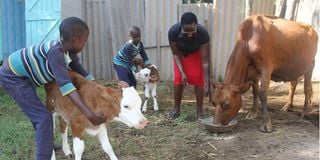Let it sink in, Cow down and downer cow not the same

A family feeds a cow and its twin calves. A cow is unlikely to stand again after being down for 14 days, animal health providers say.
So you wake up in the morning and discover that your high-yielding cow that calved down yesterday cannot stand.
Yet everything looks normal to you.
You nudge the animal to stand but it just stares at you, possibly wondering if you have any idea how her muscles feel.
I say this because every time I have attended to a cow that has gone down but looks normal, the eyes of the animal communicate an appeal for assistance.
The two illnesses that give the impression of a normal cow unable to stand are milk fever and three-day-sickness.
Milk fever arises from the animal’s inability to keep the blood-bone balance of calcium, medically called calcium homeostasis.
Under normal circumstances, the dairy cow maintains a blood calcium concentration of 2.1 to 2.5 millimoles per litre of blood.
The balance is maintained by dynamic movement of calcium from the gut to the blood and to the bones.
When there is low dietary calcium getting into the blood, the body draws the element from the bones.
Milk fever occurs when the animal loses the ability to maintain normal blood calcium level.
This is caused by many factors such as excessive feeding of calcium, inadequate calcium in the diet or rapid withdrawal of calcium from the body as happens with high milk yield and the formation of foetal bones in the uterus.
In the early stages of milk fever, the animal may go down and still look normal to the untrained eye before deteriorating into a sickly state.
Three-day sickness or ephemeral fever, on the other hand, is a viral disease.
It is mainly transmitted by ticks and biting insects. The animal goes down but still appears normal.
It usually recovers and stands about 72 hours later, hence the name of the disease.
There is no known cure for ephemeral fever and supportive treatment does not appear to affect the course of the disease.
Treated or not, the animal recovers on its own in one to seven days.
I recall when I was growing up, some animals would just fail to stand for a whole day and we found them up within the next two days.
We used to think the animals had been tired and had just decided to rest.
The main cause of the inability to stand is microscopic muscle and nerve damage that resolves on its own within the sickness period.
Going back to your cow that will not stand, a number of farmers have asked me why some are called downer cows and others said to be milk fever or three-day-sickness.
Know from today that there are “cows down” and “downer cows”. The animals cannot stand in both cases.
A cow is said to be recumbent when it is unable to stand.
A recumbent cow is often described as being “down”. When it has been recumbent for more than 24 hours, it is called a “downer cow”.
Other causes of a cow going down and later becoming a downer are trauma at or after calving, bone fractures and nerve paralysis.
There is also severe malnutrition and toxic diseases such as mastitis, metritis and over-feeding on grains and grain products.
When a cow lies down normally, it keeps shifting its weight gently and relieves pressure on parts of the body that are in contact with the ground.
Farmers do not observe the periodic sifting of weight because it is gentle and not expected.
A cow that has gone down because of a problem will remain static in one position, causing severe pressure on the parts of the body in contact with the ground.
The pressure causes muscle and nerve damage. If the cow is down for long, the damage is severe enough to prevent the animal from standing and it becomes a downer.
The signs seen on a downer are that the cow has recently calved (usually within 48 hours but has been down for more than 24 hours).
The animal lies on the breast bone, is alert and makes no effort to stand.
The cow also often eats, drinks, passes urine and defecates.
Some downers may move around on the fore limbs and are called creepers.
The term downer cow is therefore an ambiguous diagnosis when the primary cause of going down is not known or when the going down has caused damage that prevents the animal from standing after the primary problem is resolved.
Whenever I encounter a cow that is down, I first exclude all possible causes of the animal going down through thorough history-taking and clinical examination.
If I identify the primary cause of the problem, I treat the cow according to the standards prescribed.
The best way to treat a downer is to give good nursing care.
Food and water should be provided in easy-to-reach wide-based containers.
There should be nice shelter and a soft clean dry surface.
If the cow is not shifting its weight, one should ensure the animal is shifted on its sides at least twice daily.
Regular attempts to assist the cow stand should be made at least three times a day.
My star downer cow to date was recumbent for 23 days as a sequel of milk fever.
Literature documents that cows are unlikely to stand again after being down for 14 days.
The owner had insisted we do everything possible to save the animal.
On the 23rd day of rigorous treatment and care, I found the animal standing and eating as though nothing had happened before.





